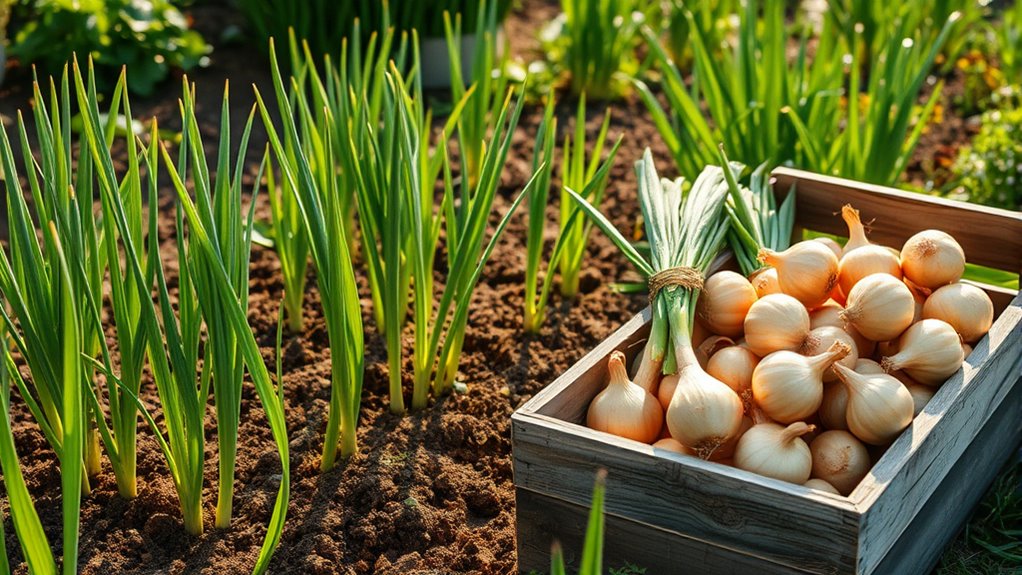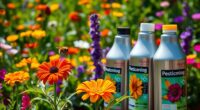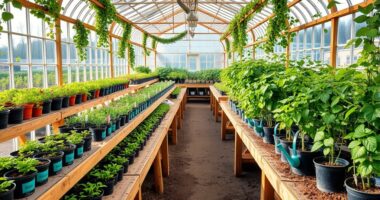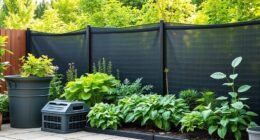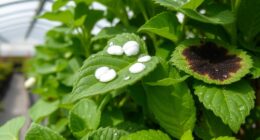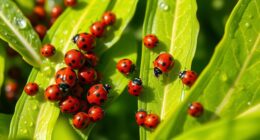Growing onions like a pro is all about the right choices and care. Start with high-quality seeds or sets, like the 3 Colors Mix for variety. Make sure you use sandy soil with good drainage and ample sunlight. Consistent watering helps, but avoid overwatering to prevent rot. Remember to thin your plants for better growth and cure your harvest properly for storage. Stick with me, and you’ll uncover even more tips to maximize your onion gardening success.
Key Takeaways
- Choose the right onion variety for your climate, such as long-day or short-day types, to ensure optimal growth conditions.
- Prepare sandy, well-draining soil with a pH of 6.0 to 7.0 and provide 6-8 hours of direct sunlight daily.
- Water consistently, aiming for about 1 inch per week, but avoid overwatering to prevent bulb rot.
- Start seeds indoors 10-12 weeks before the last frost, and transplant when the soil warms up for best results.
- Regularly inspect for pests and implement crop rotation to maintain soil health and reduce pest pressure.
3 Colors Mix Onion Sets for Gardening

If you’re looking to add vibrant colors and flavors to your garden, the 3 Colors Mix Onion Sets are an excellent choice for both novice and experienced gardeners. These GMO-free bulbs come in a delightful mix of yellow, red, and white onions, perfect for enhancing your culinary creations. I love how easy they are to grow, providing a continuous harvest throughout summer. Whether you enjoy crisp salads or savory soups, these onions deliver! Just make sure they get full sun or partial shade and moderate watering. Trust me, you won’t regret adding this colorful trio to your garden!
Best For: This product is best for both novice and experienced gardeners looking to enhance their gardens with colorful and flavorful onions.
Pros:
- Easy to grow, making it suitable for beginners.
- Provides a vibrant mix of onions for culinary diversity.
- Offers a continuous harvest throughout the summer season.
Cons:
- Some customers reported small bulb sizes.
- Variable viability may affect growth consistency.
- Limited warranty information provided, available only upon request.
Mixed Onion Sets – 8 oz Non-GMO Assortment
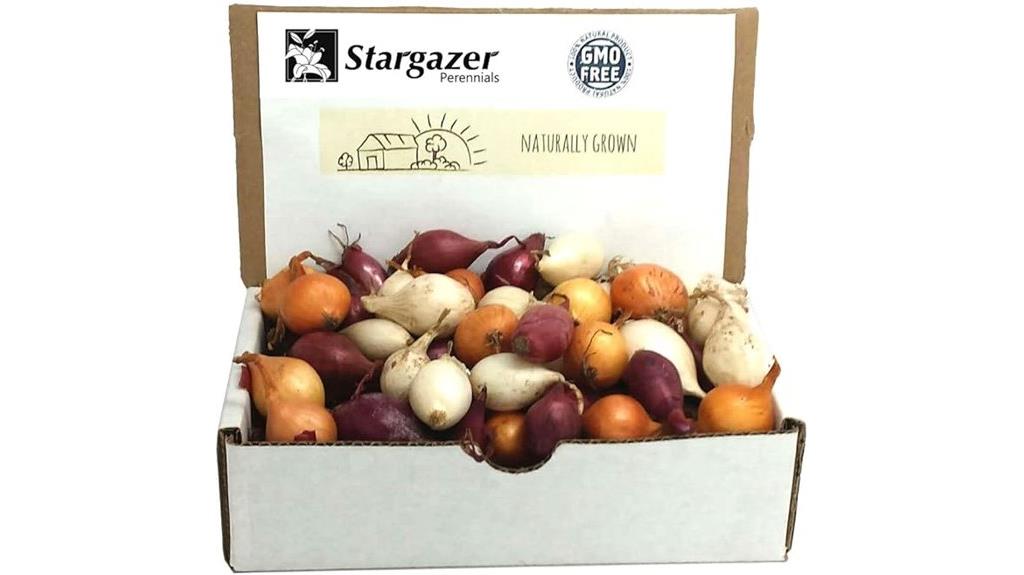
Mixed Onion Sets – 8 oz Non-GMO Assortment are perfect for anyone looking to add a variety of flavors to their home garden. This collection includes red, white, and semi-sweet yellow onion sets, totaling over 60 bulbs that are easy to grow. I’ve found they thrive in various conditions, whether in raised beds or containers. The day neutral/long day mix suits both indoor and outdoor gardening, making it versatile year-round. Customers rave about the germination rates and healthy plants, so I’m excited to plant these and anticipate a bountiful harvest come spring. You’ll love the flavors they bring to your meals!
Best For: Home gardeners looking to grow a diverse array of onions in various settings, including small gardens and containers.
Pros:
- Excellent germination rates reported by many customers, leading to healthy plants.
- Variety of onion types included—red, white, and semi-sweet yellow—for diverse culinary uses.
- Versatile growing conditions allow for indoor and outdoor gardening, making it suitable year-round.
Cons:
- Some customers experienced issues with shipping costs relative to the product price.
- A few reports of receiving dried or squishy bulbs, affecting overall satisfaction.
- Mixed experiences regarding the quantity received, with some getting more than expected while others felt shortchanged.
Easiest Green Onion Regrower with Ergonomic Lid
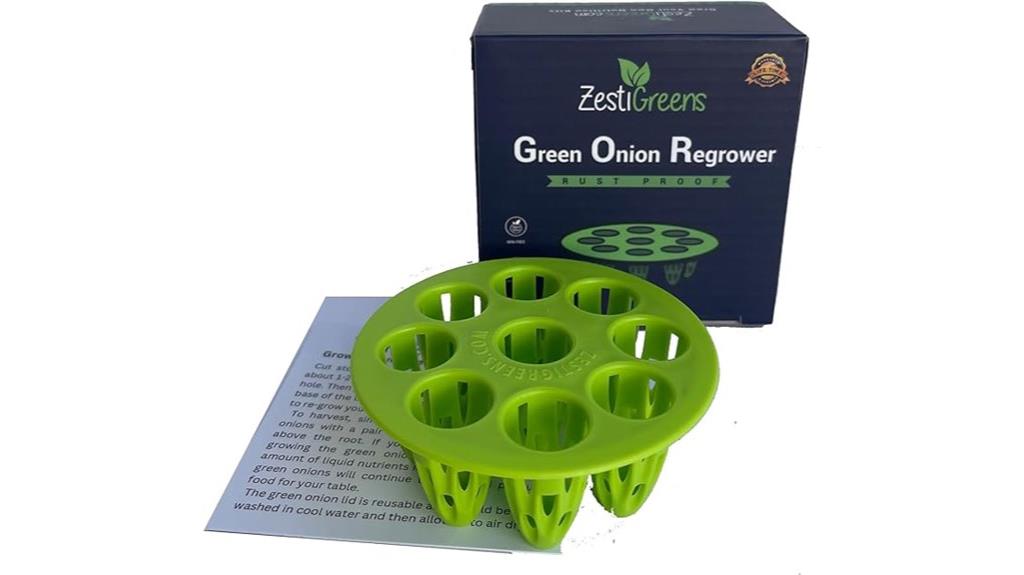
For anyone looking to grow their own green onions effortlessly, the Easiest Green Onion Regrower with an ergonomic lid is the perfect solution. I love how simple it is—just add water once, and you’ll have fresh, homegrown green onions in just seven days! The lid keeps the roots upright, ensuring they grow properly. Plus, it helps me reduce food waste by using the cut ends I’d normally toss. It’s compatible with large mouth mason jars, making it user-friendly for beginners. I highly recommend checking out this handy tool if you want fresh green onions at your fingertips!
Best For: Anyone looking to grow fresh green onions at home with minimal effort and reduce food waste.
Pros:
- Easy to use: Just add water once and watch green onions grow in 7 days.
- Sustainable: Utilizes cut root ends that would otherwise be thrown away, promoting self-sufficiency.
- User-friendly design: Ergonomic lid keeps roots upright and is compatible with large mouth mason jars.
Cons:
- Limited to specific plants: Primarily designed for green onions, may not appeal to those wanting to grow a wider variety of plants.
- Chemical smell: Some users report unpleasant smells from neoprene sleeves.
- Jar not included: Requires a separate purchase of a mason jar or wide mouth cup for use.
4 Pack Potato Grow Bags (10 Gallon)
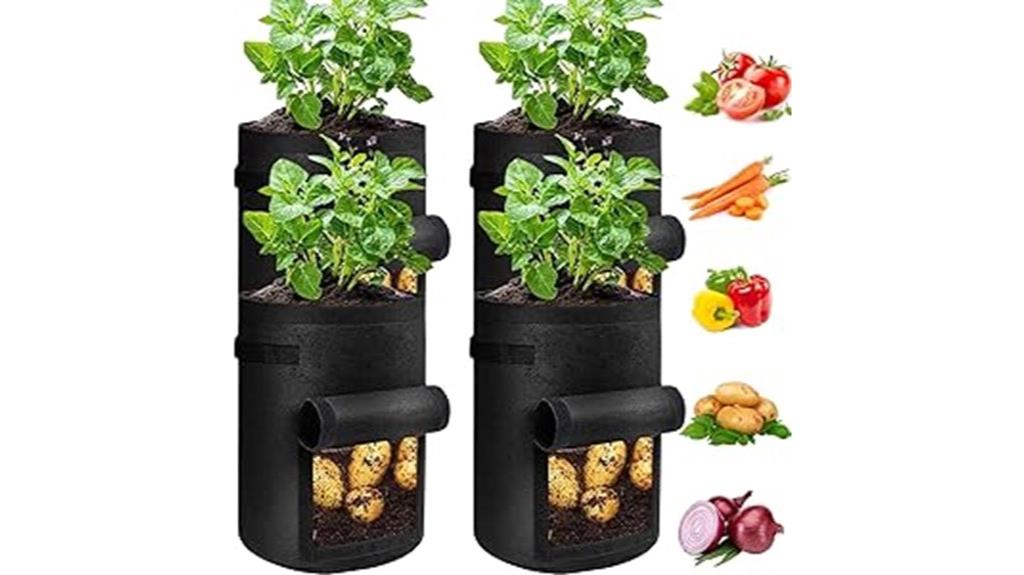
The JJGoo 4 Pack Potato Grow Bags, with their generous 10-gallon capacity, are perfect for anyone looking to maximize their vegetable harvest, especially onions. Made from heavy-duty, BPA-free fabric, these bags promote excellent airflow to the roots, preventing waterlogging and root rot. I love the large harvest window for easy access to my onions, and the durable handles make moving them a breeze. Plus, they’re designed for small spaces, ensuring I get stronger growth and higher yields. With a fantastic average rating of 4.4 stars, these bags are a reliable choice for any gardener aiming for success.
Best For: Gardeners with limited space looking to grow a variety of vegetables, especially potatoes and onions, in durable, easy-to-use bags.
Pros:
- Excellent airflow and drainage, promoting healthier plant growth and preventing root rot.
- Large harvest window for convenient access to your vegetables.
- Heavy-duty fabric and handles make for easy mobility and long-lasting use.
Cons:
- Can be heavy when filled, making them difficult to move.
- Handle length may not be ideal for all users, affecting mobility.
- Limited capacity may require multiple bags for larger harvests.
Yellow Sweet Spanish Onion Seed Packet for Planting

If you’re looking to enhance your home vegetable garden, the Yellow Sweet Spanish Onion Seed Packet is an excellent choice for both novice and experienced gardeners. This non-GMO heirloom variety produces vigorous, adaptable biennial plants that thrive in full sun. With moderate watering needs, they’re perfect for both container and ground gardens. I love their sweet, mild flavor, making them a versatile ingredient for salads, roasts, and more. Plus, they promote sustainable living, as these open-pollinated seeds guarantee high germination rates. Packaged by a small American family-owned business, it’s a great way to support local while growing delicious onions!
Best For: Home gardeners, both novice and experienced, looking to grow sweet, flavorful onions in their gardens.
Pros:
- Versatile culinary uses: Ideal for salads, roasts, and various dishes due to their sweet, mild flavor.
- Sustainable choice: Non-GMO heirloom variety that promotes self-sufficient living and supports local businesses.
- Adaptable growing conditions: Suitable for both container and ground gardens, thriving in full sun with moderate watering needs.
Cons:
- Mixed germination rates: Some users report inconsistencies in germination success, leading to variable growing experiences.
- Variable customer experiences: Feedback varies, with both positive and negative reviews regarding overall growing success.
- Biennial growth cycle: Requires patience as these plants are biennial and may take longer to produce onions compared to annual varieties.
ANGELIOX 3-Pack Grow Bags for Gardening
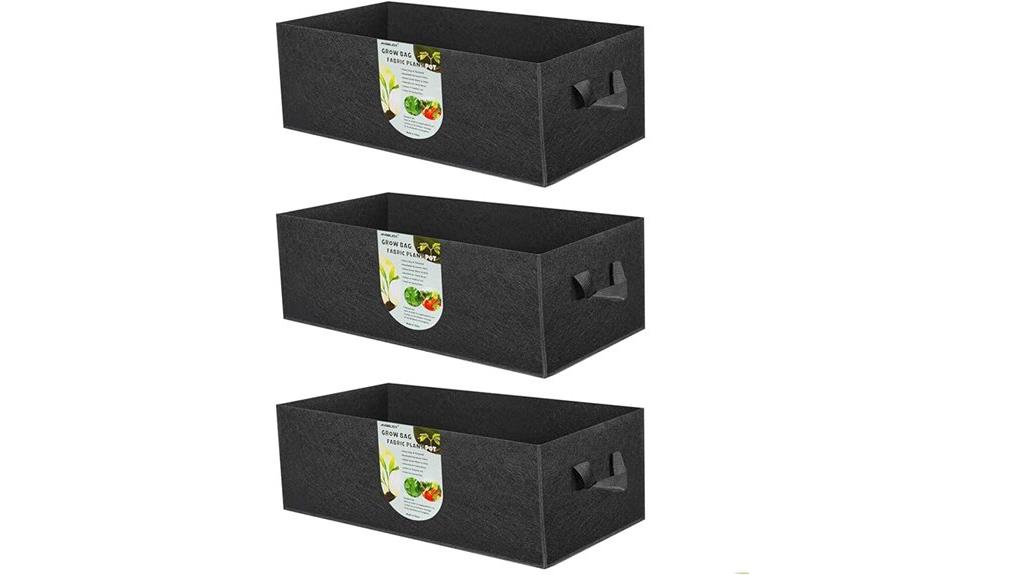
Looking for a practical solution to enhance your gardening experience? I highly recommend the ANGELIOX 3-Pack Grow Bags. Each bag holds 10 gallons, perfect for planting onions, potatoes, or even flowers. Made from durable, breathable fabric, these bags promote air circulation and prevent root rot, ensuring healthier plants. The sturdy handles make them easy to move around, which I find super convenient. Just keep in mind, they might need some support to maintain their shape once filled with soil. Overall, they’ve been a game-changer in my garden, and I’m excited to see how my onions thrive!
Best For: Gardeners looking for versatile, durable growing solutions for vegetables, fruits, and flowers in small spaces.
Pros:
- Lightweight design with sturdy handles for easy movement.
- Made from breathable fabric that promotes air circulation and prevents root rot.
- Washable and reusable, making them environmentally friendly and cost-effective.
Cons:
- Bags may lose shape when filled with soil, requiring additional support.
- Some users reported stability issues during heavy usage.
- Not ideal for very large plants without reinforcement.
Organo Republic Onion Seeds Variety Pack (Heirloom, Non-GMO)

For anyone enthusiastic to cultivate a vibrant onion garden, the Organo Republic Onion Seeds Variety Pack is an outstanding choice. With over 2,200 heirloom, non-GMO seeds, you’ll find varieties like Walla Walla, Green Onion, and Red Burgundy. Each pack comes in a waterproof resealable bag, complete with handy mini gardening tools. The high germination rate of over 90% guarantees a successful growing experience, whether indoors or outdoors. Plus, the included QR codes lead to helpful gardening guides. This variety pack makes a thoughtful gift for fellow gardeners or anyone wanting to grow fresh vegetables year-round. Happy planting!
Best For: Gardening enthusiasts, couples, vegetarians, and anyone looking to grow a variety of fresh vegetables at home.
Pros:
- High germination rate of over 90% ensures successful growth.
- Comes with mini gardening tools and a waterproof resealable bag for convenience.
- Includes QR codes for easy access to online gardening guides and culinary recipes.
Cons:
- Some customers reported issues with seed sprouting despite high germination rates.
- Not all varieties may thrive in every climate or growing condition.
- Limited to onion varieties, which may not suit all gardeners’ preferences.
Seed Packet – Onion Evergreen Bunching

The Back to the Roots Onion Evergreen Bunching Seed Packet is perfect for anyone wanting to grow fresh, flavorful onions at home. These organic, non-GMO seeds weigh 200mg and are highly rated by fellow gardeners. I love that germination takes just 10-14 days, and I can start them indoors 7-9 weeks before the last frost. When transplanting, I make sure to space them 1-2 inches apart for bunching. I wait until the green tops drop down to know they’re ready for harvest. With proper storage, I keep them fresh and enjoy my homegrown bounty all season long!
Best For: Home gardeners looking to grow organic, flavorful onions with minimal effort and quick germination.
Pros:
- Organic & Non-GMO: Ensures a natural growing experience without harmful chemicals.
- Quick Germination: Seeds sprout in just 10-14 days, allowing for a faster gardening cycle.
- Versatile Use: Can be harvested for both mature bulbs and flavorful green tops.
Cons:
- Limited Space Requirements: Requires careful spacing (1-2 inches) for bunching, which may not be ideal for larger gardens.
- Indoor Start Needed: Requires starting indoors before transplanting, which may be an extra step for some gardeners.
- Harvest Timing: Must wait for tops to drop down, which might require patience and careful observation.
Organic Walla Walla Onion Seeds (Approx 200 Seeds)
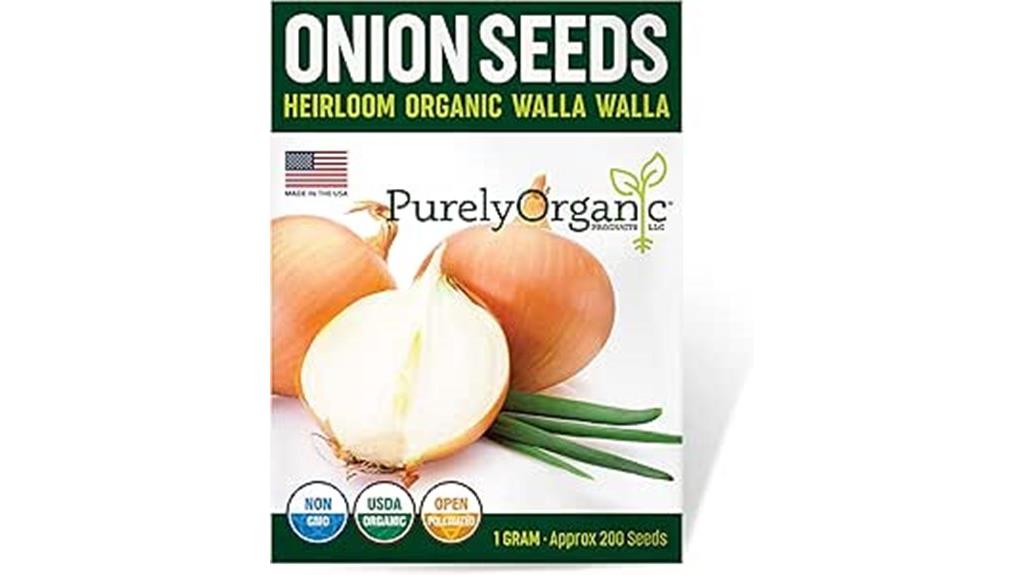
If you want to grow onions that bring a delightful sweetness to your dishes, then Organic Walla Walla Onion Seeds are a fantastic choice. These heirloom seeds produce 4-5 inch onions that are perfect for a variety of culinary applications. I love that they’re USDA Organic and non-GMO, ensuring a healthier garden. Start them indoors about 10-12 weeks before the last frost, then transplant them outdoors when the soil warms up. Once the tops turn yellow, it’s time to harvest. Dry them in the sun for a few days, and you’ll have delicious, sweet onions stored for later use.
Best For: Home gardeners looking to grow sweet, organic onions for culinary use.
Pros:
- USDA Organic and non-GMO, ensuring a healthier gardening option.
- High germination rates with freshly packed seeds for the current season.
- Attracts pollinators and is drought-tolerant, promoting a sustainable garden.
Cons:
- Requires specific planting times and conditions for optimal growth.
- May not be suitable for regions outside USDA Hardiness Zones 3-10.
- Harvesting and storage require proper techniques to ensure longevity.
Potato Grow Bags, 4 Pack 10 Gallon Planter Pots

Potato grow bags, specifically the 4-pack 10-gallon planter pots, are perfect for anyone looking to maximize their vegetable garden’s potential, especially if you’re keen on growing onions. Made from durable PE material, these bags are suitable for both indoor and outdoor planting. I love the ventilated holes that promote healthy root growth and the strong handles that make moving them a breeze. They’re lightweight and sturdy, ensuring multiple seasons of use. After using them, I’ve had great success with onions and other veggies, making them a fantastic choice for anyone wanting to enhance their gardening experience.
Best For: Gardeners looking to maximize small spaces and grow a variety of vegetables, especially root crops like potatoes and onions.
Pros:
- Durable Construction: Made from strong, long-lasting PE material suitable for multiple seasons.
- Healthy Growth Environment: Ventilated holes promote good drainage and root health.
- Easy to Move: Strong handles allow for effortless relocation of the bags.
Cons:
- Initial Quality Issues: Some users reported cuts or defects from packaging.
- Size Limitation: While 10 gallons is suitable for many plants, it may be limiting for larger vegetable varieties.
- Requires Careful Handling: Being lightweight can make them susceptible to tipping over in strong winds or heavy rain.
4 Pack 10 Gallon Potato Grow Bags for Planting Vegetables and Flowers
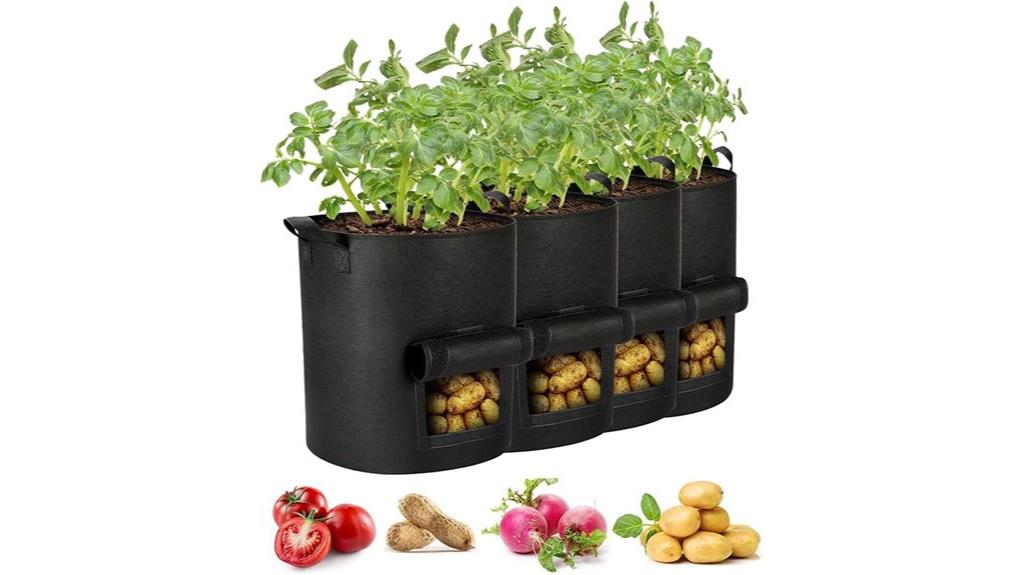
For anyone looking to maximize their gardening potential, these 10-gallon grow bags are a fantastic choice, especially when cultivating vegetables like onions. I love how the breathable, nonwoven fabric allows air and water to flow, promoting healthy growth. With sturdy handles, I can easily transport them, even when they’re full of soil. These bags fit perfectly in small spaces like my patio or balcony, and they’re versatile enough for other vegetables and flowers too. Plus, the front opening makes checking on my plants and harvesting a breeze. They’ve truly become a staple in my gardening arsenal!
Best For: Gardening enthusiasts looking to grow a variety of vegetables and flowers in small spaces.
Pros:
- Versatile design suitable for various plants including potatoes, tomatoes, and herbs.
- Breathable nonwoven fabric promotes healthy growth with excellent drainage.
- Sturdy handles make it easy to transport even when filled with soil.
Cons:
- Some concerns about durability when bags are heavily loaded with soil.
- Limited to a 10-gallon capacity, which may not be sufficient for larger plants.
- May require careful handling to avoid tearing, especially when full.
Sweet Yellow Onion Sets for Growing Vegetables

Sweet Yellow Onion sets are perfect for anyone looking to grow flavorful, healthy onions in their garden. I’ve found these sets ideal for salads, soups, and more. They thrive in all zones and are easy to care for, especially during cooler months. While some customers have reported poor growth or received dried bulbs, my experience has generally been positive with good-sized, healthy sets. I recommend checking the condition upon arrival and using the right fertilizer for peak taste. Just be mindful of pricing; some options out there can be more budget-friendly. Happy gardening!
Best For: Those looking to grow flavorful and healthy onions in their home gardens, especially in cooler climates.
Pros:
- Easy to grow and care for, suitable for all gardening zones.
- Versatile for various culinary uses such as salads and soups.
- Generally good-sized and healthy bulbs when received in optimal condition.
Cons:
- Some customers experience poor growth with low sprouting rates.
- Occasional issues with receiving dried or damaged bulbs upon arrival.
- Higher price point compared to bulk options available at retail stores.
Sweet Red Onion Sets for Growing Onions

If you’re looking to add a burst of flavor to your salads and soups, consider the Sweet Red Onion Sets for growing fresh onions right in your garden. These onions thrive in cooler weather and are perfect for home gardening. I’ve found them quick to sprout, offering a satisfying gardening experience. Although reviews are mixed—some users report no sprouts while others enjoy healthy growth—the initial packaging and appearance are often praised. With a bit of care, you can enjoy delicious, sweet red onions that elevate your dishes. Just remember to plant them during the cooler seasons for the best results!
Best For: Home gardeners looking to grow flavorful onions in cooler weather.
Pros:
- Quick to sprout, providing a rewarding gardening experience.
- Suitable for various dishes, enhancing flavors in salads and soups.
- Positive feedback on packaging and initial appearance.
Cons:
- Mixed reviews with some customers reporting no sprouts after several weeks.
- Concerns about shriveled onions and low sprouting rates.
- Requires planting during cooler seasons for optimal results.
Factors to Consider When Choosing Onion Growing

When I choose onions for my garden, I always consider a few key factors that can make or break my crop. From selecting the right varieties to understanding soil type and sunlight exposure, each element plays an essential role in my success. Plus, I need to keep an eye on the planting timeframe and watering needs to guarantee my onions thrive.
Onion Varieties Selection
How do you choose the right onion variety for your garden? First, think about the flavor you want—sweet, mild, or zesty. Yellow, red, and white onions each bring something unique to your dishes. Next, consider your growing zone; some onions thrive in USDA Hardiness Zones 2-10 and need specific climates to flourish. Make sure to pick between short-day and long-day onions based on where you live—short-day for the south and long-day for the north. Also, check the growing season; most onions are planted in spring and harvested in summer, but some can overwinter for an early harvest. Finally, think about how you’ll use them—varieties like Walla Walla are great for fresh eating, while others are better for cooking or storage.
Soil Type Considerations
Choosing the right soil type is critical for growing healthy onions, as the wrong conditions can hinder their development. I’ve found that onions thrive best in sandy soil, which allows for good drainage and prevents waterlogging—important for root health. Aim for a soil pH between 6.0 and 7.0 to guarantee ideal nutrient absorption. Adding organic matter like compost not only improves soil structure but also enhances moisture retention and provides necessary nutrients. I always keep in mind that moderate watering is crucial; onions need consistent moisture but can rot in overly saturated soil. Using raised beds or containers is a great way to control soil quality and drainage, making my onion-growing experience even better.
Sunlight Exposure Requirements
After ensuring the right soil type for my onions, I turn my attention to their sunlight exposure requirements. Onions thrive in full sun, needing at least 6 to 8 hours of direct sunlight daily for ideal growth and bulb development. In hotter climates, I’ve found that providing partial shade during the hottest part of the day helps prevent bolting and reduces stress on the plants. If they don’t get enough sunlight, the bulbs can turn out smaller and less flavorful, as onions rely on photosynthesis to build energy and sugars. When planning my garden, I always consider the sunlight patterns throughout the day and season, ensuring my onions receive the light they need, whether in the ground or in containers.
Planting Timeframe Guidelines
Timing is essential when it comes to planting onions in your garden. I’ve learned that spring is the best time, but you’ll want to pay attention to your local frost dates. For long-day varieties, plant when day lengths exceed 14 hours, while short-day types thrive with less than 12 hours of daylight. To get a jumpstart, I usually start my onion seeds indoors about 10-12 weeks before the last frost and then transplant them outdoors 4-6 weeks before that date. Onions prefer cooler weather, so early spring planting often yields better results than waiting until summer in warmer climates. Watch for the tops to yellow and fall over; that’s when your onions are ready to harvest!
Watering Needs Management
Once your onions are in the ground, managing their watering needs becomes a key factor in their growth. Onions require moderate watering, so I keep the soil consistently moist but not waterlogged to prevent root rot. During the growing season, I aim for about 1 inch of water per week, adjusting based on rainfall and soil type. Overwatering can lead to soft, rotting bulbs, while underwatering results in stunted growth and smaller sizes. I make it a habit to monitor soil moisture regularly, especially during warm weather or dry spells. Additionally, I find that mulching around my onion plants helps retain soil moisture, reducing the frequency of watering and promoting healthier growth.
Pest and Disease Control
While growing onions can be rewarding, it’s vital to stay vigilant about pests and diseases that can threaten your crop. I regularly inspect my onion plants for pests like aphids, thrips, and onion maggots, as they can cause significant damage if not controlled promptly. Implementing crop rotation has also helped me reduce pest pressure in the soil. When needed, I use organic or chemical insecticides, making sure they’re safe for my onions and effective against the specific pests. Proper watering techniques are important, too, as overly moist conditions can lead to fungal diseases like downy mildew. Finally, I keep the growing area clean and free of debris to minimize hiding spots for pests and reduce disease spread.
Harvesting Techniques and Timing
Knowing when to harvest your onions is essential for getting the best flavor and storage life. I usually wait until the tops begin to yellow and fall over, which signals that the bulbs are mature. For green onions, I pick them anytime they reach about 6-8 inches tall, allowing for continuous harvesting without uprooting the bulb. For yellow and red onions, I aim to harvest when the bulb skins are dry and the tops have fallen over, typically around mid to late summer. To prevent rot, I cure the onions in a dry, warm place for a few days after harvesting. And remember, I always dig them up carefully with a garden fork to minimize damage and improve their storage potential.
Storage and Preservation Methods
After harvesting onions, the next step involves understanding how to store and preserve them effectively. I find that the best way to prolong their shelf life is to store them in a cool, dry, and well-ventilated area, ideally between 32°F and 40°F. Properly curing the onions by drying them in a warm, airy place for two to three weeks helps the outer skins become papery while reducing moisture content. For long-term storage, I use mesh bags or baskets to allow airflow and prevent rot. If I want to preserve them further, I freeze chopped onions after blanching or dehydrate them. Dehydrated onions stay flavorful for up to a year when kept in airtight containers away from light.
Frequently Asked Questions
How Do I Know When My Onions Are Ready to Harvest?
When I’m figuring out when my onions are ready to harvest, I look for a few signs. First, the tops start to yellow and fall over, which tells me they’re maturing. I also check the size; if they feel firm and look plump, that’s a good indication. Finally, I gently dig around the bulbs to see if they’ve reached my desired size. Once I see all these signs, I know it’s time to harvest!
Can Onions Be Grown in Containers or Pots?
Absolutely, I’ve had great success growing onions in containers! I usually choose deep pots, at least 12 inches, to give the roots plenty of room. I’ve found that using quality potting soil helps them thrive. Just make sure they get enough sunlight—about six hours a day works well for me. Watering is key; I keep the soil moist but not soggy. With some care, my container onions have turned out fantastic!
What Pests Are Common for Onion Crops?
When I grow onions, I often encounter a few common pests. Onion flies are a real nuisance, laying eggs near the base of plants. I’ve also dealt with thrips, which can cause stunted growth and discoloration. Sometimes, I spot aphids hanging around, sucking the sap. To combat these pests, I usually check my plants regularly and consider natural remedies, like insecticidal soap, to keep my onion crop healthy and thriving.
How Can I Store Harvested Onions for Longevity?
Did you know that properly stored onions can last up to six months? When I harvest my onions, I make sure to cure them first by placing them in a warm, dry spot for a couple of weeks. Once they’re cured, I store them in a cool, dark place like my pantry. I avoid plastic bags, opting for mesh or paper bags instead, which helps them breathe and stay fresh longer.
What Is the Best Time of Year to Plant Onions?
When I think about the best time to plant onions, I usually aim for early spring or late summer, depending on whether I’m growing them as spring or fall crops. I’ve found that onions thrive when planted about 4-6 weeks before the last frost date. It’s also essential to take into account my local climate, as it can influence the timing. Trust me, timing can make all the difference in a successful onion harvest!
Conclusion
In my garden, each onion I grow feels like a small treasure, a golden orb of potential waiting to be unearthed. Just as each layer of an onion reveals a new story, so too does every tip I’ve shared help you cultivate your own garden journey. Embrace the joy of nurturing these vibrant bulbs, and let your passion for gardening blossom. Together, we’ll watch our hard work transform into a bountiful harvest, a true reflection of our dedication.
